AN APPEAL FOR SUPPORT
- We seek your support to meet expenses relating to some new and essential software, formatting of articles and books, maintaining and running the journal through hosting, correrspondences, etc. You can use the PAYPAL link given above. Please click on the PAYPAL logo, and it will take you to the PAYPAL website. Please use the e-mail address thirumalai@mn.rr.com to make your contributions using PAYPAL.
Also please use the AMAZON link to buy your books. Even the smallest contribution will go a long way in supporting this journal. Thank you. Thirumalai, Editor.
BOOKS FOR YOU TO READ AND DOWNLOAD
- THE ROLE OF VISION IN LANGUAGE LEARNING
- in Children with Moderate to Severe Disabilities ...
Martha Low, Ph.D. - SANSKRIT TO ENGLISH TRANSLATOR ...
S. Aparna, M.Sc. - A LINGUISTIC STUDY OF ENGLISH LANGUAGE CURRICULUM AT THE SECONDARY LEVEL IN BANGLADESH - A COMMUNICATIVE APPROACH TO CURRICULUM DEVELOPMENT by
Kamrul Hasan, Ph.D. - COMMUNICATION VIA EYE AND FACE in Indian Contexts by
M. S. Thirumalai, Ph.D. - COMMUNICATION
VIA GESTURE: A STUDY OF INDIAN CONTEXTS by M. S. Thirumalai, Ph.D. - CIEFL Occasional
Papers in Linguistics,
Vol. 1 - Language, Thought
and Disorder - Some Classic Positions by
M. S. Thirumalai, Ph.D. - English in India:
Loyalty and Attitudes
by Annika Hohenthal - Language In Science
by M. S. Thirumalai, Ph.D. - Vocabulary Education
by B. Mallikarjun, Ph.D. - A CONTRASTIVE ANALYSIS OF HINDI
AND MALAYALAM
by V. Geethakumary, Ph.D. - LANGUAGE OF ADVERTISEMENTS
IN TAMIL
by Sandhya Nayak, Ph.D. - An Introduction to TESOL:
Methods of Teaching English
to Speakers of Other Languages
by M. S. Thirumalai, Ph.D. - Transformation of
Natural Language
into Indexing Language:
Kannada - A Case Study
by B. A. Sharada, Ph.D. - How to Learn
Another Language?
by M.S.Thirumalai, Ph.D. - Verbal Communication
with CP Children
by Shyamala Chengappa, Ph.D.
and M.S.Thirumalai, Ph.D. - Bringing Order
to Linguistic Diversity
- Language Planning in
the British Raj by
Ranjit Singh Rangila,
M. S. Thirumalai,
and B. Mallikarjun
REFERENCE MATERIAL
- UNIVERSAL DECLARATION OF LINGUISTIC RIGHTS
- Lord Macaulay and
His Minute on
Indian Education - In Defense of
Indian Vernaculars
Against
Lord Macaulay's Minute
By A Contemporary of
Lord Macaulay - Languages of India,
Census of India 1991 - The Constitution of India:
Provisions Relating to
Languages - The Official
Languages Act, 1963
(As Amended 1967) - Mother Tongues of India,
According to
1961 Census of India
BACK ISSUES
- FROM MARCH 2001
- FROM JANUARY 2002
- INDEX OF ARTICLES
FROM MARCH, 2001
- SEPTEMBER 2005 - INDEX OF AUTHORS
AND THEIR ARTICLES
FROM MARCH, 2001
- SEPTEMBER 2005
- E-mail your articles and book-length reports (preferably in Microsoft Word) to thirumalai@mn.rr.com.
- Contributors from South Asia may send their articles to
B. Mallikarjun,
Central Institute of Indian Languages,
Manasagangotri,
Mysore 570006, India or e-mail to mallikarjun@ciil.stpmy.soft.net - Your articles and booklength reports should be written following the MLA, LSA, or IJDL Stylesheet.
- The Editorial Board has the right to accept, reject, or suggest modifications to the articles submitted for publication, and to make suitable stylistic adjustments. High quality, academic integrity, ethics and morals are expected from the authors and discussants.
Copyright © 2004
M. S. Thirumalai
THE USE OF ENGLISH IN STORE SIGNBOARDS IN BHUBANESWAR
Vijay K. Sunwani, Ph.D.
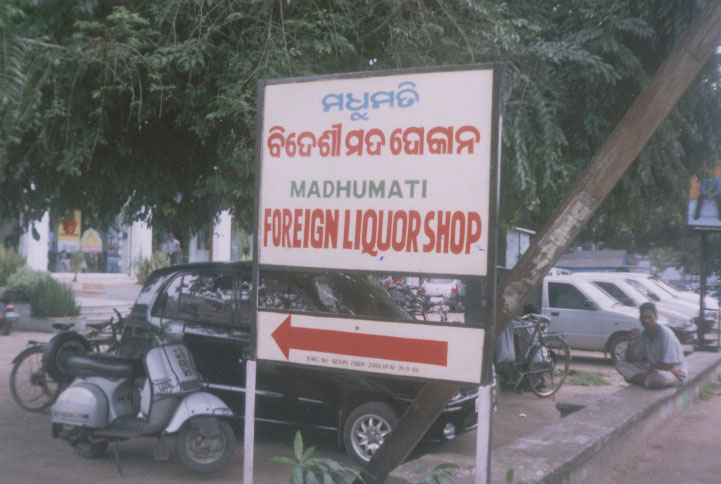
INTRODUCTION
In this paper I propose to study some of the shop signs in the city of Bhubaneswar. Many languages, such as English, Hindi, Oriya and Bengali, are used in the signboards in Bhubaneswar. Sometimes we find the use of Gurmukhi, Arabic or even Japanese in signboards in Bhubaneswar. Through this study I hope to arrive at an understanding of the use and roles of different languages in the business establishments, and in business advertisements.
BHUBANESWAR
Known as the Cathedral city of India, Bhubaneswar is the capital of Orissa, one of the states in Eastern India. The name, Bhubaneswar, probably consists of two words, Bhawan "abode" and Eswar, god or gods. That is, the combined word means that the city is the abode of gods. Old Bhubaneswar dates back to at least 1100 A.D., the approximate date of the Lingaraj Temple.
Modern Bhubaneswar, which was planned in 1956, is a sprawling city still growing in all directions, including vertical. It has plenty of interesting sights to offer. One of the interesting place to visit is the Pathani Samanta Planetarium, or is it Planetorium? Even the authorities are in doubt about the spelling and so perhaps that particular section of the signboard is specially blurred: take whatever spelling you find best suited to you, or whichever suits you at the moment. Nearby is a large piece of land with a signboard stating that it is the site for the Museum for Natural History. A bit further away is the Regional Research Laboratory. Continue on the same road till we hit the Institute of Physics. Opposite the Planetarium / Planetorium is Utkal University.
In this paper I propose to look at the signboards of shops in the city of Bhubaneswar, and to see and study what really they mean, and what kind of language they use and such other related issues.
UNILINGUAL SIGNBOARDS
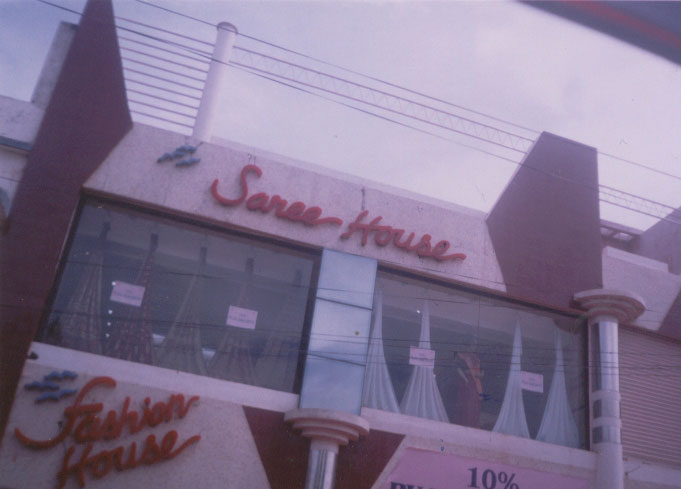
Unilingual signboards are displayed in English, Hindi, Bengali and Oriya, all by themselves. For instance, we see a lot of signboards in English:
| Shackles | Archies | Asha | Hallmark |
In Hindi, either feminine names or the names of gods or goddesses are preferred.
Sudha Sujata Durga Jai Hanuman
Ganesh Ganga Prafful Saraswati
Jai Santoshi Kaveri Pushpa Shri Ram
In Oriya, we have examples such as
| Utkalika | Boyanika | Narayan Ayurveda | Pragyan | Prativa |
Most of the signboards use the English script. There are, however, signboards in which only the Oriya script is used. Very rarely do we find the use of the Oriya script in other signboards, even though use of Oriya in signboards has been made mandatory since June 2003. In some signboards, the year of the setting up of the shop is also indicated to inform the public about the shop's stability, and to convince people that they can trust the shop for quality and other values.
Similarly, the shop's anniversary is also proudly announced as in the signboard, "The 5th year of The Raymond Shop."
BILINGUAL SIGNBOARDS
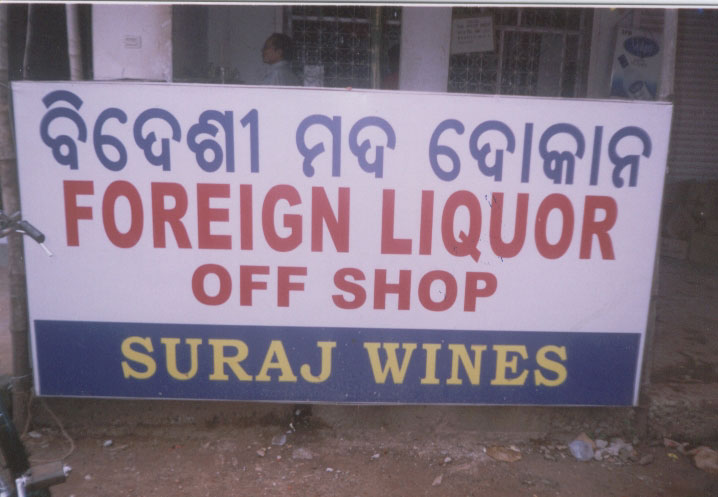
Bilingualism is a way of life in India. Generally every Indian wants to use all the languages he or she knows simultaneously, and in the same single sentence! The shop signboards are no exception to this oral speech behavior. So, most signboards are bilingual. The bilingualism of the signboards is displayed in two ways
- Combining two languages in the same sentence.
- Writing the main signboard in one language, followed by its translation in another language.
It may be mentioned that by bilingual I mean the use of English and Hindi. A restaurant such as Shri Kunj announces itself as an eatery both in English and Hindi. Half of the title Shri is in Hindi, while the other half Kunj is in English in the same line.
Signboards exhibit a lot of such creativity in word making.
Bilingual would also mean using English and Oriya. A signboard written in English is rendered into Oriya, such as Bikalananda Kar & Sons, Ramakrushna and Sons. This is more of a transliteration.
An Oriya dining place carries the name Hotel Oddisha in Sahid Nagar. These are the more conservative places of business, which want to cater specially for the local people and, in a manner of speaking, uphold the Government. order that the shop must have the Oriya writing on it specifying the goods.
In contrast to this, the English-Hindi combine shop-owners want to woo the floating population from neighboring Chhatisgarh and M.P., and other communities, who use Hindi. The Hindi-knowing population in this city has grown tremendously in the last few decades, contributing its own share in making Bhubaneswar a multilingual metropolis.
TRILINGUAL SIGNBOARDS
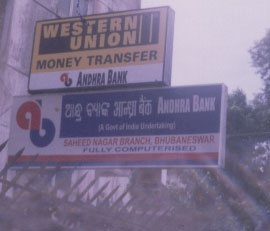
Following the three-language formula almost all Central Government institutions display their office signs in Oriya, Hindi and English with letters of the same size in all the languages. The Regional College of Education, a branch of the NCERT, a Central government institution, displays the names of the faculty on the plates fixed on the doors of the faculty members in three languages.
These signboards on government institutions serve a basic purpose. They are meant to inform you without much ado. The pattern is the same: it has been officially stated as the language code. Therefore the government signboards are staid, plain, prosaic, and very unattractive, and visible if the foliage has not covered the signboards.
ENGLISH PREFERRED
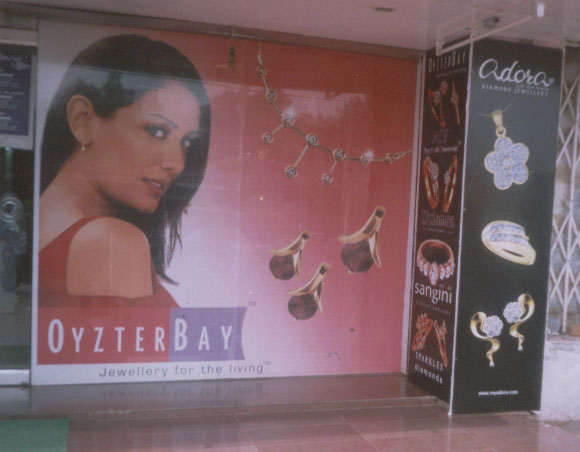
The shop signs in Bhubaneswar are almost always in English, whether the owner understands and speaks the language or not. One such word was the use of Enterprisers. One would have a lot of difficulty understanding what did Vijay Enterprisers mean. These days, fortunately, shop owners have started using Enterprises, much to the relief of many English language teachers.
Asked why did the grocery seller prefer the signboard in English, the grocery seller did not hesitate to mention that it was a trendy language and that people came wherever English pointed the way, as on the milestones.
Acronyms
Often the signboards are reveal their content only using acronyms. To begin with, Bhubaneswar itself will be shortened to BBS or BBSR. We hardly see the whole word written anywhere. And no where such usage is demanded, be it government office or private business.
National Aluminium Company, Anugul is generally known as NALCO.
Other such examples are
GAIL, SAIL, BSNL, VSNL, CIPET, CIFA, IDCOL, NINL, ATB RIE OUAT PTI
One more variety that we can find is the new use of Old English
The Ceat Shoppe
Ye Olde Shoppe
Fashion Shoppe
The logo of the Oriya television Channel is in English : OTV. The advertisements and / or jingles are given in English or in Hindi or a mixture of the two. The panel discussions that take place on OTV are either in Oriya and English, Oriya and Hindi, or Oriya and local Oriya. This last makes it a bit too thick for the non-Oriyas to follow, for the participants use what is called Kanthi Oriya.
HYBRID FORMS
The day's round up is known as Pratidin News. Notice the use of the words there: Pratidin can be Hindi or Oriya, News is English, Pratidin News is hybrid.
This hybrid form of using the language has caught up with Doordarshan's Morning Show as well and with so many satellite channels offering to enliven your breakfast. You learn many other languages besides your own depending on the state you are living in.
But we are in Orissa, where you generally begin the day by getting some milk. No, dairy is passé. You get milk from the Omfed counter. If you have noticed, Omfed's Unique Selling Proposition seems to be English. Buy the varieties in English, be it any kind of milk:
Toned, double toned, non fat
Or flavoured, chocolate, badam, elaichi
Or buttermilk
Or 200 gms of factory packed paneer
Or the chenna poda that comes to you in a poly pack
Fortunately, the advertisements for all these products on the OTV are in Oriya so that it can reach the remotest corner of the State.
Even consumer durables manufactured in Bhubaneswar are marketed in English: Patriot coolers and desert coolers, Konark Television sets, etc. Even if you look around these products with a magnifying glass, you will not find any Oriya anywhere.
The use of English is to suggest that the West has all positive values. The use of Oriya and Hindi also promises that if English is positive, we in this region who are using Hindi and Oriya are more positive than the West. Thus all school names are in English
Capital High School
Unit IX Girls High School
Vivekananda School
St. Joseph's High School
Stewart School
D.M.School
Prabhujee English Medium School Ruchika
Satya Sai School
Often English sentences or phrases and names may be written entirely using the Hindi script, as in Panda Enterprises. Likewise, Hindi materials may be written entirely in the Roman script giving an English "flavor," to the text.
Suhane Safar ki Shuruat
Khul Ja Sim-Sim 2003 (Satyam Shivam Sundaram)
Loot Lo Khajana (Hosiery sale)
Amul: Attallee Buttellee Amul(notice the play on the former P.M's name.)
Aa Abu Laut Chale(Abu Salem)
Hum Aapke Hain Gone(Remember the Film?)
Food festivals in important hotels and restaurants are advertised only in English
Biryani Festival
Dum Pukht cooking
Kashmiri food festival
Thai Food Festival
Genuine Oriya food
French Cuisine
English Breakfast
Continental Chicken
Shop signboards do surrogate advertising such as
Bagpiper aqua
Aristocrat Aqua
Gold Riband aqua
Mera Soda No. 1
They all indirectly refer to hard liquors with names such as Bagpiper, Aristocrat, etc. One does not have to figure out what the advertisement is about.
I have yet to see a neon light advertisement in Bhubaneswar for a product in Oriya. For those in English, they can be found at important crossroads.
Camaro Jeans
LG electronics
BPL
Samsung
Hyundai
Kinetic
Honda
Zen
Panasonic
Pallio
Many a time it is only the logo, or brand name, that attracts the people, who ultimately buy it. The product is sold. Such is the semiotics of language use in advertising. Just look at the logos of State Bank, Andhra Bank, ICICI or the ATM sign if you are in a fix at midnight.
Or select consumer durables from the logos of
HCL
Titan
LG
Whirlpool
Kissan
Maggi
Lakme
Elle 18
HMT
Sumeet
Knorr
Godrej
Peter England
Axe
Astra
Television and the mass media have influenced the people of Bhubaneswar as much as they have the people of other cities. But Bhubaneswar specially, because it is just two hours flying distance from Delhi. An item manufactured today in Delhi, two hours later you should not be surprised to find it in the Orissan capital.
A recent change that one notices is that those items generally referred to in English are advertised in Hindi / Oriya and vice versa. For instance, Rupa : ganjee, banian. Although we do have equivalent words (brief and vest, etc.) for these objects in English, local words would be used instead.
We celebrate marriage receptions in a Marriage Hall, or the Kalyan Mandap. Kalyan Mandap is totally Indian, but written as such in Roman script. We go on strikes at the drop of a hat and therefore English terms are also used for those on Relay Fast and dharnas. These are also advertised on slogans and banners written in large English letters.
Creativity in language use is seen in naming products manufactured locally. We have heard of a chalk stick like device, designed to keep pests and insects away. It is suitably marketed as Lakshman Rekha. It is a homespun idiom taken literally from mythology which works as a figurative and carries the meaning of the product effectively.
Similarly, the festival of Raja Parva literally celebrates the girl's coming of age. And with Sabitri as the name of a sari shop one can expect great sales symbolizing as it does the mythological devotion of a wife to her husband.
People are generally unable to distinguish between wine and alcohol. Shopkeepers, that is. They want the product to sell. We find the signboards of wine shops announcing
Suraj Wines
Madhushala
Maikhana
Devdas
Daru Sura
What they really mean is the IMFL (India made foreign liquor) that is sold there. All these have caught on, specially after the release of the film Devdas. And Madhushala in MP means a place where you get sugar cane juice and Bachhan's Madhushala is a different affair altogether. Foreign Liquor Off Shop is perhaps what it should read. One shop owner, too tipsy perhaps, made it Foreign Liquor of (sic) Shop.
All the star hotels have by and large got English names and displayed in Roman script, and they do not risk to advertise themselves in the local languages.
Bicky’s Inn The New Marrion Swosti Plaza The Oberoi Pal Heights
Kalinga Ashoka Triumph Regency Regency Crown Presidency
Food Ville May Fair Arya Palace Richie Keshari
Hotel Sishmo Pizza Hut Akbari Govind a/c Regal
Royale Midtown Suvarna a/c Priya Lavendar a/c Bapu
I think the meaning is clear. Eat Indian, Order English, or is it the other way round? And after a full stomach you do need a dessert, or perhaps an ice cream? Take your pick.
Fried Ice cream
Banana Split
Butterscotch
Vanilla
Frostee
Pistachhio
Jamaican Surprise
Honey & nuts
Vanilla with hot chocolate
Choose your sweets and pastries as well:
Black Forest
Chocolate delight
Plain Cream
Pineapple
Kalakand
Chocolate Barfi
Rasgulla
Malai chop
Chum chum
Sohanpapri
Others looking for a place under the sun are
Gokul Bhog
Makhan Chor
Haldiram's
Jalaram
Shree Ram snacks
Woodlands
Khana Khazana
Mirch Masala
Ganguram
Asli dhabha
Naqli dhabha
Tandoor Delights
Some Jewellery?
Tanishq
Bishandayal
Lalchand
Syndicate
Khimji
Epari Govindam
Kanak
Devi
Heena
Jewels in English, no Oriya , no Hindi.
Cloth stores do jam the traffic, specially in Bhubaneswar, so
Traffic Jam
Stop
Saree House
Benares Beauty
Usha
Mahesh Cloth
Mona Lisa
Burma
Paridhaan
Libas Kolkata Bazar
RoopMandir
Sumangal
Satyam Shivam Sundaram
So from this corpus of about 200 names what do we arrive at? And the list is not yet complete. One can go on adding to the list with variations that will spring many a surprise.
CONCLUSION
It may therefore be seen that English is the dominant language of the signboards in the shops in Bhubaneswar.
Language is used as a status marker as well. Small shops, conscious about it, use Oriya in their shops. They would also love to use English, though. The signboards have developed special syntax in the variety of English we use. This English is an extension of our daily language, Hindi or Oriya. The idea is primarily to establish a profitable (financial) communication.
In this paper, I have tried to study about 200 signboards. In no case is the list exhaustive, it is only representative. For the English teacher the study can be helpful to linking language(s) with idea(s). Shops and their signboards constitute a part of the real life of the students. We mould English to suit our own circumstances, making it more relevant to our needs, colorful and authentic.
Language becomes strong and relevant when it is linked to concepts and ideas that are meaningful to you and to the society. A market place, a shopping mall, with its signboards, interactions between people, interaction between customers and shopkeepers, provides a kind of ready-made situation for language learning. Content in this context is interwoven with language.
CLICK HERE FOR PRINTER-FRIENDLY VERSION.
THE USE OF ENGLISH IN STORE SIGNBOARDS IN BHUBANESWAR | LANGUAGE OF POLITICAL POWER IN KERALA | A COMPREHENSIVE STUDY OF WORD FORMATION IN TAMIL | EDUCATION OF THE TRIBAL GIRLS IN ORISSA -- A STUDY ON ATTITUDE AND LANGUAGE OF INSTRUCTION | PRACTICING LITERARY TRANSLATION - A SYMPOSIUM BY MAIL | LEARNING ENGLISH VOCABULARY AT THE PRIMARY LEVEL - A FREQUENCY COUNT OF THE VOCABULARY OF THE TEXTBOOKS USED IN ANDHRA PRADESH | FEMINIST CONTRIBUTION TO INDIAN SOCIOLOGY - A Book by Shalinee Gusain | HOME PAGE | CONTACT EDITOR
Vijay Sunwani, Ph.D.
Regional Insitute of Education
Bhubaneswar 751022, Orissa
India
vksunwani@rediffmail.com
- Send your articles
as an attachment
to your e-mail to
thirumalai@mn.rr.com. - Please ensure that your name, academic degrees, institutional affiliation and institutional address, and your e-mail address are all given in the first page of your article. Also include a declaration that your article or work submitted for publication in LANGUAGE IN INDIA is an original work by you and that you have duly acknolwedged the work or works of others you either cited or used in writing your articles, etc. Remember that by maintaining academic integrity we not only do the right thing but also help the growth, development and recognition of Indian scholarship.

